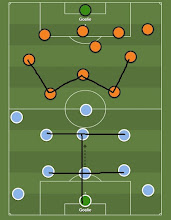The 1997 U20 World Cup in Malaysia marked a new era for FIFA’s youth
showpiece, with a significant expansion in the number of participants.
The 1997
Tournament in Numbers
* Six host cities: Shah Alam, Kuantan, Kangar, Johor Bahru, Alor Setar and
Kuching.
* With the exception of UEFA, every confederation was handed more slots.
Asia, Africa and CONCACAF doubled their representation from two to four, while
South America gained one extra spot. Oceania, meanwhile, received an automatic
berth.
* Four debutants made the stage: Belgium, South Africa, the UAE and hosts
Malaysia.
Argentina
Won Back-to-Back
Argentina followed in the footsteps of Brazil and Portugal by becoming just the third nation to successfully defend their title. Once again under the guidance of José Pékerman – the man who had steered them to glory in Qatar two years earlier – the Albiceleste produced another triumphant campaign, though it wasn’t always smooth sailing.
The final against Uruguay proved a stern test. La Celeste had already eliminated the USA, France (featuring Thierry Henry) and Ghana on their way to the showpiece. And when Pablo García’s free-kick ripped into the net to give Uruguay the lead, it looked like Argentina’s defence of the crown might be over.
But Pékerman’s side roared back. Esteban Cambiasso levelled the score,
before Diego Quintana grabbed the decisive goal to seal a 2-1 win – and
Argentina’s third U20 World Cup trophy.
Tournament Highlights
|
Grup A |
Grup B |
Grup C |
|
Uruguay |
Brasil |
Ghana |
|
Morocco |
France |
Ireland |
|
Belgium |
South Africa |
USA |
|
Malaysia |
South Korea |
PRC |
|
Grup D |
Grup E |
Grup F |
|
Spain |
Australia |
England |
|
Japan |
Argentina |
Mexico |
|
Paraguay |
Canada |
UEA |
|
Costa Rica |
Hungary |
Ivory Coast |
** = penalties
* = extra time
Round of 16:
-
Uruguay
vs USA 3-0
-
Mexico
vs France 0-1
-
Australia
vs Japan 0-1
-
Ghana
vs UEA 3-0
-
Spanyol
vs Canada 2-0
-
Ireland
vs Morocco 2-1
-
England
vs Argentina 1-2
-
Brasil
vs Belgium 10-0
Quarterfinal:
-
Uruguay
vs France 1-1 (7-6)**
-
Japan
vs Ghana 1-2*
-
Spain
vs Ireland 0-1
-
Brasil
vs Argentina 0-2
Semifinal:
-
Uruguay
vs Ghana 3-2*
-
Ireland
vs Argentina 0-1
3rd place Playoff : Ireland vs Ghana 2-1
Final:
Top scorer: Adailton (Brasil) – 10 gol
MVP: Nicolas Olivera
(Uruguay)
From Youth to Stardom
|
Players |
World Cup
edition (senior) |
|
Willy Sagnol
(France) |
2002, 2006 |
|
Mikael
Silvestre (France) |
2002, 2006 |
|
William Gallas
(France) |
2006, 2010 |
|
Thierry Henry
(France) |
1998, 2002,
2006, 2010 |
|
Kwame Agboh
(France/Togo) |
2006 |
|
David Trezeguet
(France) |
1998, 2002,
2006 |
|
Nikolas Anelka
(France) |
2010 |
|
Benny McCarthy
(South Africa) |
1998, 2002 |
|
Matthew Booth
(South Africa) |
2010 |
|
Douglas
Sequeira (Costa Rica) |
2006 |
|
Carlos Castro
(Costa Rica) |
2002 |
|
Pablo
Chinchilla (Costa Rica) |
2002 |
|
Steven Bryce
(Costa Rica) |
2002 |
|
Tsuneyasu
Miyamoto (Japan) |
2002, 2006 |
|
Kazuykui Toda
(Japan) |
2002 |
|
Tomokazu
Myojin (Japan) |
2002 |
|
Atsushi
Yanagisawa (Japan) |
2002. 2006 |
|
Shunsuke
Nakamura (Japan) |
2006, 2010 |
|
Justo Villar (Paraguay) |
2002, 2006,
2010 |
|
Paulo da Silva
( |
2006, 2010 |
|
Cesar Ramirez
( |
1998 |
|
Gustavo
Morinigo ( |
2002 |
|
David Albelda
(Spanyol) |
2002, 2006 |
|
Gustavo Munua
( |
2002 |
|
Pablo Garcia ( |
2002 |
|
Nicolas
Olivera ( |
2002 |
|
Fabian Carini
( |
2002 |
|
Alejandro
Lembo ( |
2002 |
|
Manuel
Regueiro ( |
2002 |
|
Li Weifeng
(PRC) |
2002 |
|
Li Tie (PRC) |
2002 |
|
Yang Pu (PRC) |
2002 |
|
Stephen Appiah
( |
2006, 2010 |
|
Damien Duff
(Ireland) |
2002 |
|
Josh Wolff
(USA) |
2002, 2006 |
|
John O’Brien
(USA) |
2002, 2006 |
|
Ben Olsen (USA) |
2006 |
|
Matthew Upson
(England ) |
2010 |
|
Michael Owen
(England ) |
1998, 2002,
2006 |
|
Jamie
Carragher (England) |
2002, 2006 |
|
Kieron Dyer
(England) |
2002 |
|
Bonaventura
Kalou (Ivory Coast) |
2006 |
|
Leo Franco ( |
2006 |
|
Leandro Cufre
( |
2006 |
|
Walter Samuel
( |
2002, 2010 |
|
Esteban
Cambiasso ( |
2006 |
|
Roman Riquelme
( |
2006 |
|
Pablo Aimar ( |
2002, 2006 |
|
Lionel Scaloni
( |
2006 |
|
Brett Emerton
( |
2006 |
|
Lucas Neill ( |
2006. 2010 |
|
Vince Grella ( |
2006, 2010 |


Comments
Post a Comment